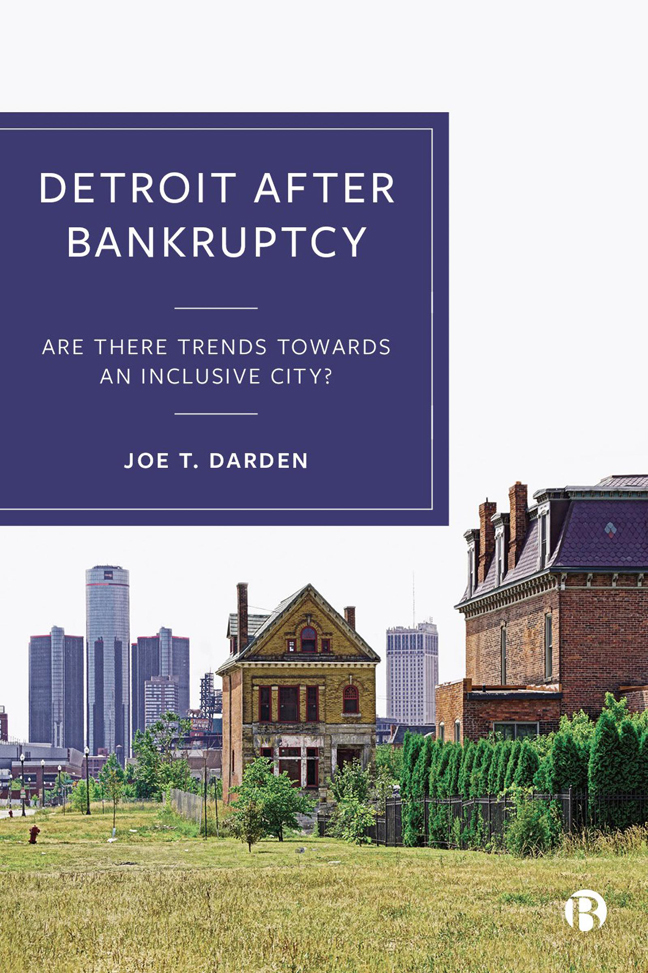Book contents
- Frontmatter
- Dedication
- Contents
- List of Figures and Tables
- Acknowledgments
- Preface
- 1 Antecedents to Bankruptcy
- 2 Detroit Bankruptcy: The Characteristics of the Decision Makers and the Differential Benefits Afterwards
- 3 The Postbankruptcy Social and Spatial Structure of Metropolitan Detroit: Anatomy of Class and Racial Residential Segregation
- 4 Gentrification: A New Method to Measure Where the Process Is Occurring by Neighborhood
- 5 The Uneven Distribution of Economic Redevelopment: Which Neighborhoods Are Excluded?
- 6 Black and Hispanic Underrepresentation in Business Ownership in a Majority-Black City
- 7 Racial Inequality in Student Academic Achievement Levels: A Neighborhood Solution to the Problem
- 8 Unequal Exposure to Crime in the City of Detroit: A New Method to Measure Exposure by the Characteristics of Neighborhoods
- 9 Solving the Problem of Extreme Race and Class Inequality: Implementing the Spatial Mobility Alternative
- 10 Conclusions: The Status of the Residents of Detroit after Bankruptcy
- References
- Index
Preface
Published online by Cambridge University Press: 25 January 2024
- Frontmatter
- Dedication
- Contents
- List of Figures and Tables
- Acknowledgments
- Preface
- 1 Antecedents to Bankruptcy
- 2 Detroit Bankruptcy: The Characteristics of the Decision Makers and the Differential Benefits Afterwards
- 3 The Postbankruptcy Social and Spatial Structure of Metropolitan Detroit: Anatomy of Class and Racial Residential Segregation
- 4 Gentrification: A New Method to Measure Where the Process Is Occurring by Neighborhood
- 5 The Uneven Distribution of Economic Redevelopment: Which Neighborhoods Are Excluded?
- 6 Black and Hispanic Underrepresentation in Business Ownership in a Majority-Black City
- 7 Racial Inequality in Student Academic Achievement Levels: A Neighborhood Solution to the Problem
- 8 Unequal Exposure to Crime in the City of Detroit: A New Method to Measure Exposure by the Characteristics of Neighborhoods
- 9 Solving the Problem of Extreme Race and Class Inequality: Implementing the Spatial Mobility Alternative
- 10 Conclusions: The Status of the Residents of Detroit after Bankruptcy
- References
- Index
Summary
Bankruptcy ended in Detroit on December 11, 2014. This book begins its assessment of the major questions that policy makers, city residents, and the private sector want answered: have there been measurable changes in the city in certain critical areas that impact the quality life of the city's residents? Is there measurable evidence that the residents are experiencing a higher quality of life? This book is my third investigation of these questions. The first book, Detroit: Race and Uneven Development (1987), with co authors Richard Hill (sociology), June Thomas (urban planning), and Richard Thomas (American history), included a detailed investigation that revealed that racial differences in the quality of life in Detroit presented a deep problem for many Blacks in the city that was getting worse over time. Moreover, the problems of the city could not be addressed without examining the Detroit Metropolitan region as a whole. After the investigation we concluded that “racial polarization between Detroit and its suburbs will increase along with the class gap between the poor in the central city and affluent in the suburbs. Detroit's financial problems are likely to worsen and the city's political influence in the region will continue to decline” (Darden et al, 1987: 254). We further concluded that “most who leave Detroit will continue to be white and affluent, but a sizable number of middle class Blacks will also migrate to the suburbs. The geographical line between Blacks and whites will still be rigidly drawn. Those remaining in the central city will be mostly Black and mostly poor” (Darden et al, 1987: 255). The book was published more than 25 years before Detroit's bankruptcy. We investigated the City of Detroit from different perspectives and came to a consensus that the rigid race and class divides were the driving forces that helped to explain the continued problems of Detroit following the Second World War. We argued that the problems of Metropolitan Detroit, such as economic decentralization, chronic racial and class residential segregation, and regional political fragmentation, were predicable trends that had gradually escalated throughout the post-Second World War period. We presented policy recommendations for Detroit’s problems that focused on how to handle the rigid divide by race, class, and place of residence.
- Type
- Chapter
- Information
- Detroit after BankruptcyAre There Trends towards an Inclusive City?, pp. xi - xivPublisher: Bristol University PressPrint publication year: 2023

